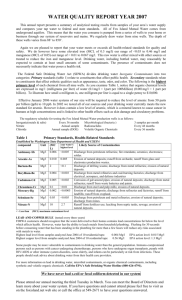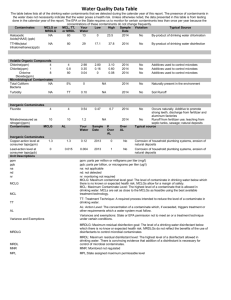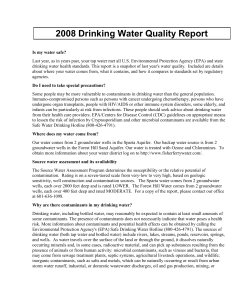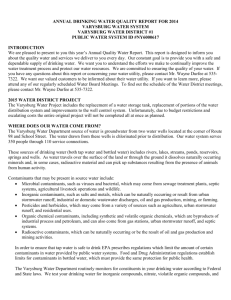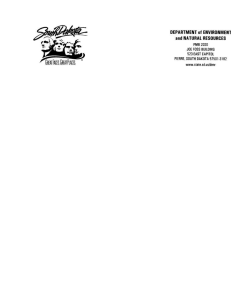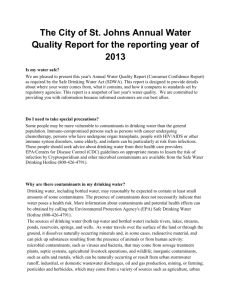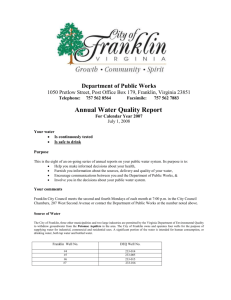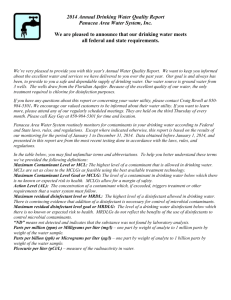2012-Annual-Water-Quality-Report-for-water-bills
advertisement
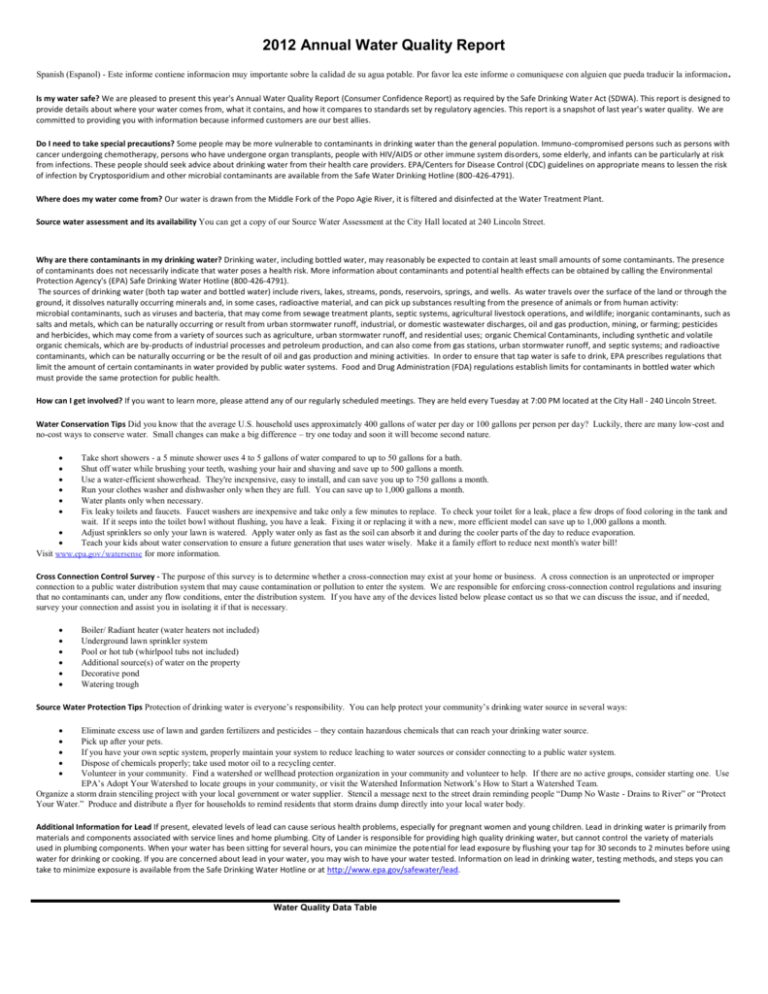
2012 Annual Water Quality Report Spanish (Espanol) - Este informe contiene informacion muy importante sobre la calidad de su agua potable. Por favor lea este informe o comuniquese con alguien que pueda traducir la informacion . Is my water safe? We are pleased to present this year's Annual Water Quality Report (Consumer Confidence Report) as required by the Safe Drinking Water Act (SDWA). This report is designed to provide details about where your water comes from, what it contains, and how it compares to standards set by regulatory agencies. This report is a snapshot of last year's water quality. We are committed to providing you with information because informed customers are our best allies. Do I need to take special precautions? Some people may be more vulnerable to contaminants in drinking water than the general population. Immuno-compromised persons such as persons with cancer undergoing chemotherapy, persons who have undergone organ transplants, people with HIV/AIDS or other immune system disorders, some elderly, and infants can be particularly at risk from infections. These people should seek advice about drinking water from their health care providers. EPA/Centers for Disease Control (CDC) guidelines on appropriate means to lessen the risk of infection by Cryptosporidium and other microbial contaminants are available from the Safe Water Drinking Hotline (800-426-4791). Where does my water come from? Our water is drawn from the Middle Fork of the Popo Agie River, it is filtered and disinfected at the Water Treatment Plant. Source water assessment and its availability You can get a copy of our Source Water Assessment at the City Hall located at 240 Lincoln Street. Why are there contaminants in my drinking water? Drinking water, including bottled water, may reasonably be expected to contain at least small amounts of some contaminants. The presence of contaminants does not necessarily indicate that water poses a health risk. More information about contaminants and potential health effects can be obtained by calling the Environmental Protection Agency's (EPA) Safe Drinking Water Hotline (800-426-4791). The sources of drinking water (both tap water and bottled water) include rivers, lakes, streams, ponds, reservoirs, springs, and wells. As water travels over the surface of the land or through the ground, it dissolves naturally occurring minerals and, in some cases, radioactive material, and can pick up substances resulting from the presence of animals or from human activity: microbial contaminants, such as viruses and bacteria, that may come from sewage treatment plants, septic systems, agricultural livestock operations, and wildlife; inorganic contaminants, such as salts and metals, which can be naturally occurring or result from urban stormwater runoff, industrial, or domestic wastewater discharges, oil and gas production, mining, or farming; pesticides and herbicides, which may come from a variety of sources such as agriculture, urban stormwater runoff, and residential uses; organic Chemical Contaminants, including synthetic and volatile organic chemicals, which are by-products of industrial processes and petroleum production, and can also come from gas stations, urban stormwater runoff, and septic systems; and radioactive contaminants, which can be naturally occurring or be the result of oil and gas production and mining activities. In order to ensure that tap water is safe to drink, EPA prescribes regulations that limit the amount of certain contaminants in water provided by public water systems. Food and Drug Administration (FDA) regulations establish limits for contaminants in bottled water which must provide the same protection for public health. How can I get involved? If you want to learn more, please attend any of our regularly scheduled meetings. They are held every Tuesday at 7:00 PM located at the City Hall - 240 Lincoln Street. Water Conservation Tips Did you know that the average U.S. household uses approximately 400 gallons of water per day or 100 gallons per person per day? Luckily, there are many low-cost and no-cost ways to conserve water. Small changes can make a big difference – try one today and soon it will become second nature. Take short showers - a 5 minute shower uses 4 to 5 gallons of water compared to up to 50 gallons for a bath. Shut off water while brushing your teeth, washing your hair and shaving and save up to 500 gallons a month. Use a water-efficient showerhead. They're inexpensive, easy to install, and can save you up to 750 gallons a month. Run your clothes washer and dishwasher only when they are full. You can save up to 1,000 gallons a month. Water plants only when necessary. Fix leaky toilets and faucets. Faucet washers are inexpensive and take only a few minutes to replace. To check your toilet for a leak, place a few drops of food coloring in the tank and wait. If it seeps into the toilet bowl without flushing, you have a leak. Fixing it or replacing it with a new, more efficient model can save up to 1,000 gallons a month. Adjust sprinklers so only your lawn is watered. Apply water only as fast as the soil can absorb it and during the cooler parts of the day to reduce evaporation. Teach your kids about water conservation to ensure a future generation that uses water wisely. Make it a family effort to reduce next month's water bill! Visit www.epa.gov/watersense for more information. Cross Connection Control Survey - The purpose of this survey is to determine whether a cross-connection may exist at your home or business. A cross connection is an unprotected or improper connection to a public water distribution system that may cause contamination or pollution to enter the system. We are responsible for enforcing cross-connection control regulations and insuring that no contaminants can, under any flow conditions, enter the distribution system. If you have any of the devices listed below please contact us so that we can discuss the issue, and if needed, survey your connection and assist you in isolating it if that is necessary. Boiler/ Radiant heater (water heaters not included) Underground lawn sprinkler system Pool or hot tub (whirlpool tubs not included) Additional source(s) of water on the property Decorative pond Watering trough Source Water Protection Tips Protection of drinking water is everyone’s responsibility. You can help protect your community’s drinking water source in several ways: Eliminate excess use of lawn and garden fertilizers and pesticides – they contain hazardous chemicals that can reach your drinking water source. Pick up after your pets. If you have your own septic system, properly maintain your system to reduce leaching to water sources or consider connecting to a public water system. Dispose of chemicals properly; take used motor oil to a recycling center. Volunteer in your community. Find a watershed or wellhead protection organization in your community and volunteer to help. If there are no active groups, consider starting one. Use EPA’s Adopt Your Watershed to locate groups in your community, or visit the Watershed Information Network’s How to Start a Watershed Team. Organize a storm drain stenciling project with your local government or water supplier. Stencil a message next to the street drain reminding people “Dump No Waste - Drains to River” or “Protect Your Water.” Produce and distribute a flyer for households to remind residents that storm drains dump directly into your local water body. Additional Information for Lead If present, elevated levels of lead can cause serious health problems, especially for pregnant women and young children. Lead in drinking water is primarily from materials and components associated with service lines and home plumbing. City of Lander is responsible for providing high quality drinking water, but cannot control the variety of materials used in plumbing components. When your water has been sitting for several hours, you can minimize the potential for lead exposure by flushing your tap for 30 seconds to 2 minutes before using water for drinking or cooking. If you are concerned about lead in your water, you may wish to have your water tested. Information on lead in drinking water, testing methods, and steps you can take to minimize exposure is available from the Safe Drinking Water Hotline or at http://www.epa.gov/safewater/lead. Water Quality Data Table In order to ensure that tap water is safe to drink, EPA prescribes regulations which limit the amount of contaminants in water provided by public water systems. The table below lists all of the drinking water contaminants that we detected during the calendar year of this report. Although many more contaminants were tested, only those substances listed below were found in your water. All sources of drinking water contain some naturally occurring contaminants. At low levels, these substances are generally not harmful in our drinking water. Removing all contaminants would be extremely expensive, and in most cases, would not provide increased protection of public health. A few naturally occurring minerals may actually improve the taste of drinking water and have nutritional value at low levels. Unless otherwise noted, the data presented in this table is from testing done in the calendar year of the report. The EPA or the State requires us to monitor for certain contaminants less than once per year because the concentrations of these contaminants do not vary significantly from year to year, or the system is not considered vulnerable to this type of contamination. As such, some of our data, though representative, may be more than one year old. In this table you will find terms and abbreviations that might not be familiar to you. To help you better understand these terms, we have provided the definitions below the table. MCLG Contaminants MCL, or TT, or Your MRDLG MRDL Water Range Low High Sample Date Violation Typical Source Disinfectants & Disinfectant By-Products (There is convincing evidence that addition of a disinfectant is necessary for control of microbial contaminants) Haloacetic Acids (HAA5) (ppb) NA 60 22 NA 2012 No By-product of drinking water chlorination Total Organic Carbon(% Removal) NA TT 1.26 NA 2012 No Naturally present in the environment Chlorine (as Cl2) (ppm) 4 4 0.67 0.05 2012 No Water additive used to control microbes MPL 2 NA 2012 No Erosion of natural deposits; Leaching 1.49 Inorganic Contaminants Sodium (optional) (ppm) Microbiological Contaminants Turbidity (NTU) NA 0.3 100 NA 2012 No Soil runoff 100% of the samples were below the TT value of 0.3. A value less than 95% constitutes a TT violation. The highest single measurement was 0.251. Any measurement in excess of 1 is a violation unless otherwise approved by the state. Contaminants Your Sample # Samples Exceeds MCLG AL Water Date Exceeding AL AL 0 15 0.01 2012 0 No Corrosion of household plumbing systems; Erosion of natural deposits 1.3 1.3 0.15 2012 0 No Corrosion of household plumbing systems; Erosion of natural deposits Typical Source Inorganic Contaminants Lead - action level at consumer taps (ppb) Copper - action level at consumer taps (ppm) Undetected Contaminants The following contaminants were monitored for, but not detected, in your water. MCLG MCL or or Your Contaminants MRDLG MRDL Water Violation TTHMs [Total Trihalomethanes] (ppb) NA 80 ND No By-product of drinking water disinfection Nitrate [measured as Nitrogen] (ppm) 10 10 ND No Runoff from fertilizer use; Leaching from septic tanks, sewage; Erosion of natural deposits Antimony (ppb) 6 6 ND No Arsenic (ppb) 0 10 ND No Barium (ppm) 2 2 ND No Beryllium (ppb) 4 4 ND No Discharge from metal refineries and coal-burning factories; Discharge from electrical, aerospace, and defense industries Cadmium (ppb) 5 5 ND No Corrosion of galvanized pipes; Erosion of natural deposits; Discharge from metal refineries; runoff from waste batteries and paints Chromium (ppb) 100 100 ND No Discharge from steel and pulp mills; Erosion of natural deposits 4 4 ND No Erosion of natural deposits; Water additive which promotes strong teeth; Discharge from fertilizer and aluminum factories Cyanide [as Free Cn] (ppb) 200 200 ND No Mercury [Inorganic] (ppb) 2 2 ND No Nitrite [measured as Nitrogen] (ppm) 1 1 ND No Selenium (ppb) 50 50 ND No Thallium (ppb) 0.5 2 ND No Fluoride (ppm) Typical Source Discharge from petroleum refineries; fire retardants; ceramics; electronics; solder; test addition. Erosion of natural deposits; Runoff from orchards; Runoff from glass and electronics production wastes Discharge of drilling wastes; Discharge from metal refineries; Erosion of natural deposits Discharge from plastic and fertilizer factories; Discharge from steel/metal factories Erosion of natural deposits; Discharge from refineries and factories; Runoff from landfills; Runoff from cropland Runoff from fertilizer use; Leaching from septic tanks, sewage; Erosion of natural deposits Discharge from petroleum and metal refineries; Erosion of natural deposits; Discharge from mines Discharge from electronics, glass, and Leaching from ore-processing sites; drug factories 1,1,2-Trichloroethane (ppb) 3 5 ND No Discharge from industrial chemical factories 1,1,1-Trichloroethane (ppb) 200 200 ND No Discharge from metal degreasing sites and other factories Dichloromethane (ppb) 0 5 ND No Discharge from pharmaceutical and chemical factories 1,2,4-Trichlorobenzene (ppb) 1,2-Dichloroethane (ppb) 1,2-Dichloropropane (ppb) Benzene (ppb) 70 0 0 0 70 5 5 5 ND ND ND ND No No No No Discharge from textile-finishing factories Discharge from industrial chemical factories Discharge from industrial chemical factories Discharge from factories; Leaching from gas storage tanks and landfills Carbon Tetrachloride (ppb) 0 5 ND No Discharge from chemical plants and other industrial activities Chlorobenzene (monochlorobenzene) (ppb) Ethylbenzene (ppb) 100 100 ND No Discharge from chemical and agricultural chemical factories 700 700 ND No Discharge from petroleum refineries Xylenes (ppm) 10 10 ND No Discharge from petroleum factories; Discharge from chemical factories Styrene (ppb) 100 100 ND No Discharge from rubber and plastic factories; Leaching from landfills Tetrachloroethylene (ppb) 0 5 ND No Discharge from factories and dry cleaners Toluene (ppm) 1 1 ND No Discharge from petroleum factories 600 600 ND No Discharge from industrial chemical factories 0 2 ND No Leaching from PVC piping; Discharge from plastics factories o-Dichlorobenzene (ppb) Vinyl Chloride (ppb) Unit Descriptions Term ppm ppb Definition ppm: parts per million, or milligrams per liter (mg/L) ppb: parts per billion, or micrograms per liter (µg/L) NA ND NTU: Nephelometric Turbidity Units. Turbidity is a measure of the cloudiness of the water. We monitor it because it is a good indicator of the effectiveness of our filtration system. NA: not applicable ND: Not detected NR NR: Monitoring not required, but recommended. NTU Important Drinking Water Definitions Term MCLG MCL TT AL Definition MCLG: Maximum Contaminant Level Goal: The level of a contaminant in drinking water below which there is no known or expected risk to health. MCLGs allow for a margin of safety. MCL: Maximum Contaminant Level: The highest level of a contaminant that is allowed in drinking water. MCLs are set as close to the MCLGs as feasible using the best available treatment technology. TT: Treatment Technique: A required process intended to reduce the level of a contaminant in drinking water. AL: Action Level: The concentration of a contaminant which, if exceeded, triggers treatment or other requirements which a water system must follow. Variances and Exemptions Variances and Exemptions: State or EPA permission not to meet an MCL or a treatment technique under certain conditions. MRDLG MRDLG: Maximum residual disinfection level goal. The level of a drinking water disinfectant below which there is no known or expected risk to health. MRDLGs do not reflect the benefits of the use of disinfectants to control microbial contaminants. MRDL MRDL: Maximum residual disinfectant level. The highest level of a disinfectant allowed in drinking water. There is convincing evidence that addition of a disinfectant is necessary for control of microbial contaminants. MNR MNR: Monitored Not Regulated MPL MPL: State Assigned Maximum Permissible Level For more information please contact: Contact Name: Shane White Address: 240 Lincoln St. Lander, WY 82520 Phone: (307) 332-4291 A copy of this report is available at the City of Lander Website: www.landerwyoming.org
